Community strengthening could be considered
VerifiedAdded on 2022/09/13
|17
|4714
|16
AI Summary
Contribute Materials
Your contribution can guide someone’s learning journey. Share your
documents today.
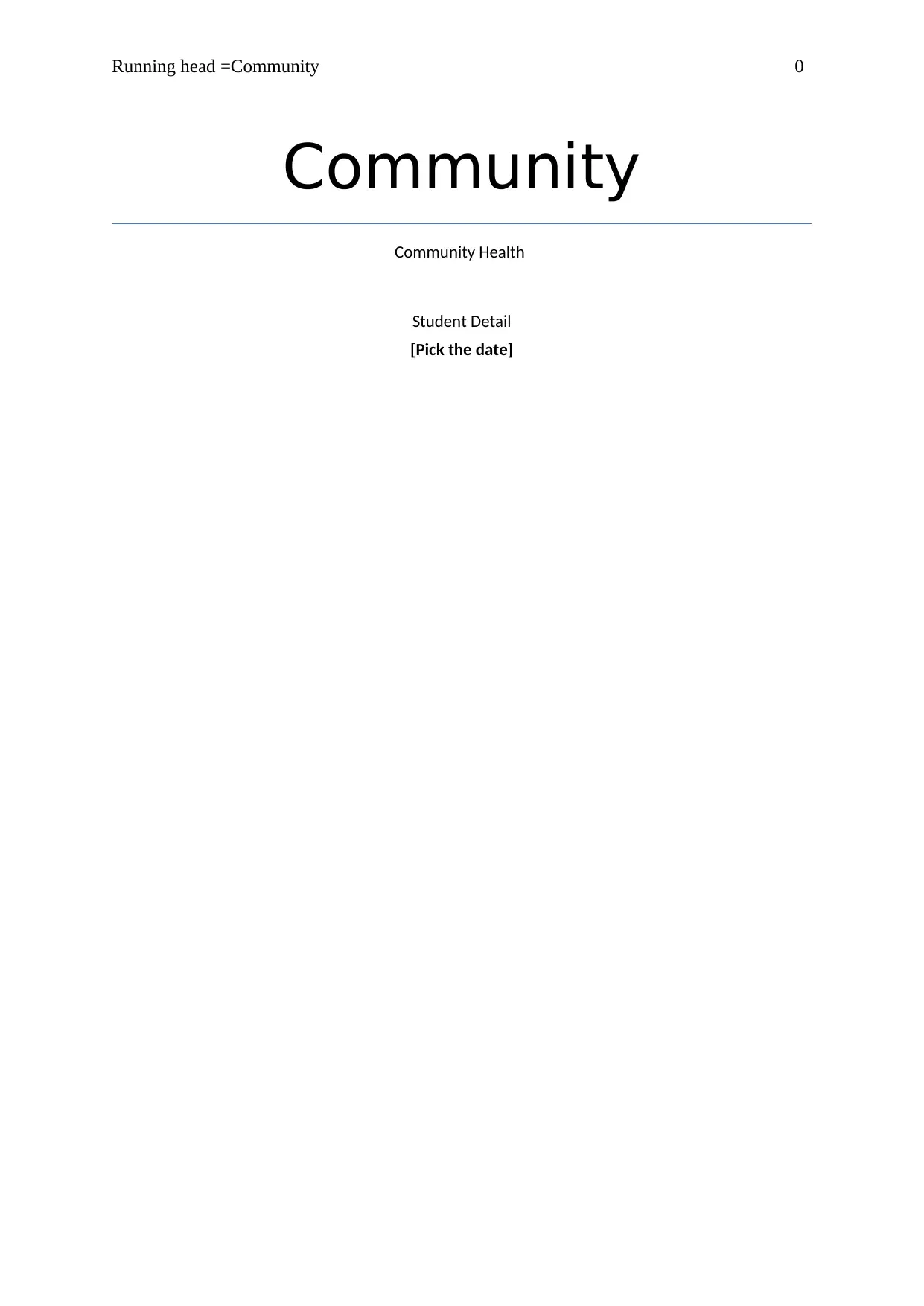
Running head =Community 0
Community
Community Health
Student Detail
[Pick the date]
Community
Community Health
Student Detail
[Pick the date]
Secure Best Marks with AI Grader
Need help grading? Try our AI Grader for instant feedback on your assignments.
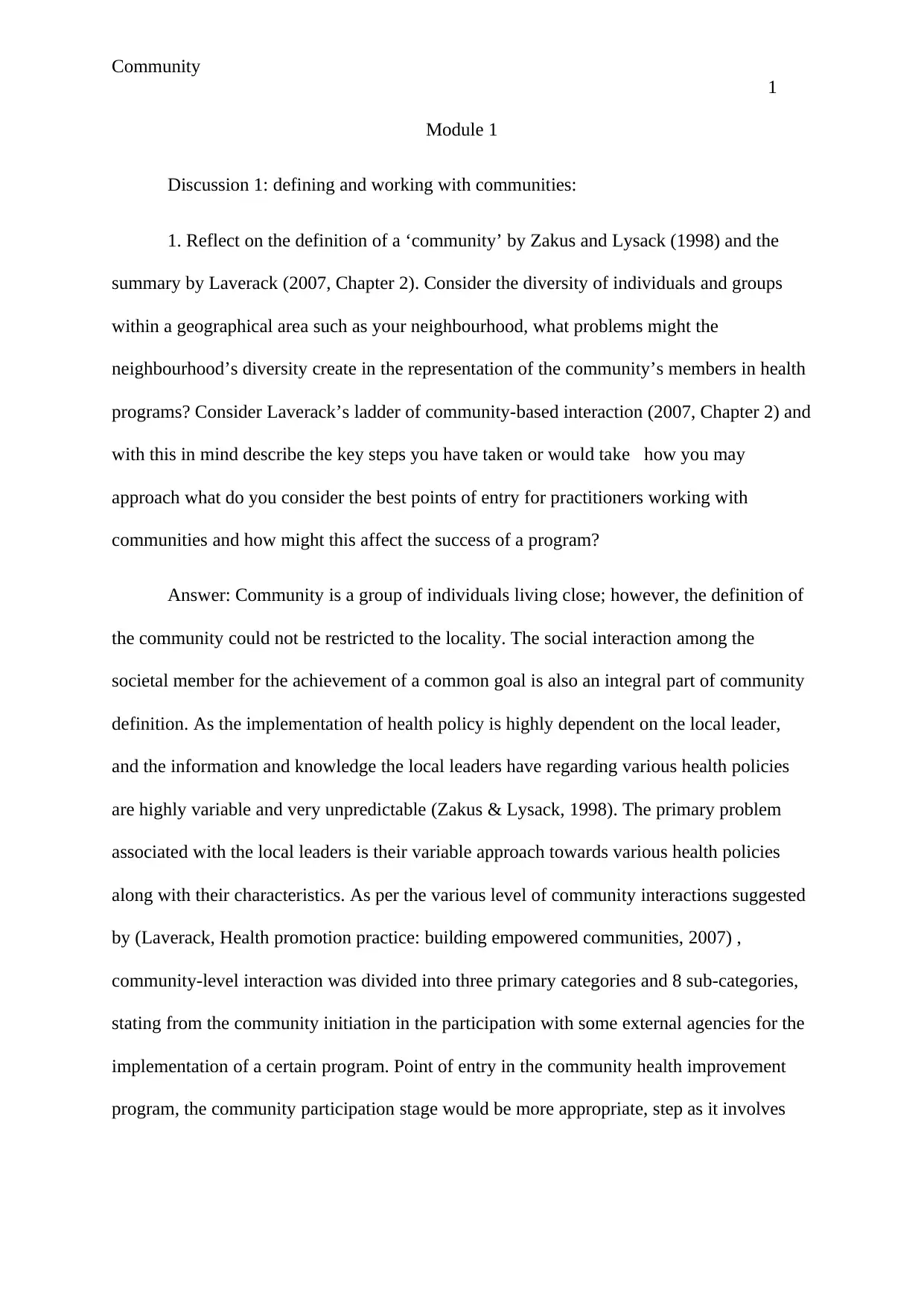
Community
1
Module 1
Discussion 1: defining and working with communities:
1. Reflect on the definition of a ‘community’ by Zakus and Lysack (1998) and the
summary by Laverack (2007, Chapter 2). Consider the diversity of individuals and groups
within a geographical area such as your neighbourhood, what problems might the
neighbourhood’s diversity create in the representation of the community’s members in health
programs? Consider Laverack’s ladder of community-based interaction (2007, Chapter 2) and
with this in mind describe the key steps you have taken or would take how you may
approach what do you consider the best points of entry for practitioners working with
communities and how might this affect the success of a program?
Answer: Community is a group of individuals living close; however, the definition of
the community could not be restricted to the locality. The social interaction among the
societal member for the achievement of a common goal is also an integral part of community
definition. As the implementation of health policy is highly dependent on the local leader,
and the information and knowledge the local leaders have regarding various health policies
are highly variable and very unpredictable (Zakus & Lysack, 1998). The primary problem
associated with the local leaders is their variable approach towards various health policies
along with their characteristics. As per the various level of community interactions suggested
by (Laverack, Health promotion practice: building empowered communities, 2007) ,
community-level interaction was divided into three primary categories and 8 sub-categories,
stating from the community initiation in the participation with some external agencies for the
implementation of a certain program. Point of entry in the community health improvement
program, the community participation stage would be more appropriate, step as it involves
1
Module 1
Discussion 1: defining and working with communities:
1. Reflect on the definition of a ‘community’ by Zakus and Lysack (1998) and the
summary by Laverack (2007, Chapter 2). Consider the diversity of individuals and groups
within a geographical area such as your neighbourhood, what problems might the
neighbourhood’s diversity create in the representation of the community’s members in health
programs? Consider Laverack’s ladder of community-based interaction (2007, Chapter 2) and
with this in mind describe the key steps you have taken or would take how you may
approach what do you consider the best points of entry for practitioners working with
communities and how might this affect the success of a program?
Answer: Community is a group of individuals living close; however, the definition of
the community could not be restricted to the locality. The social interaction among the
societal member for the achievement of a common goal is also an integral part of community
definition. As the implementation of health policy is highly dependent on the local leader,
and the information and knowledge the local leaders have regarding various health policies
are highly variable and very unpredictable (Zakus & Lysack, 1998). The primary problem
associated with the local leaders is their variable approach towards various health policies
along with their characteristics. As per the various level of community interactions suggested
by (Laverack, Health promotion practice: building empowered communities, 2007) ,
community-level interaction was divided into three primary categories and 8 sub-categories,
stating from the community initiation in the participation with some external agencies for the
implementation of a certain program. Point of entry in the community health improvement
program, the community participation stage would be more appropriate, step as it involves
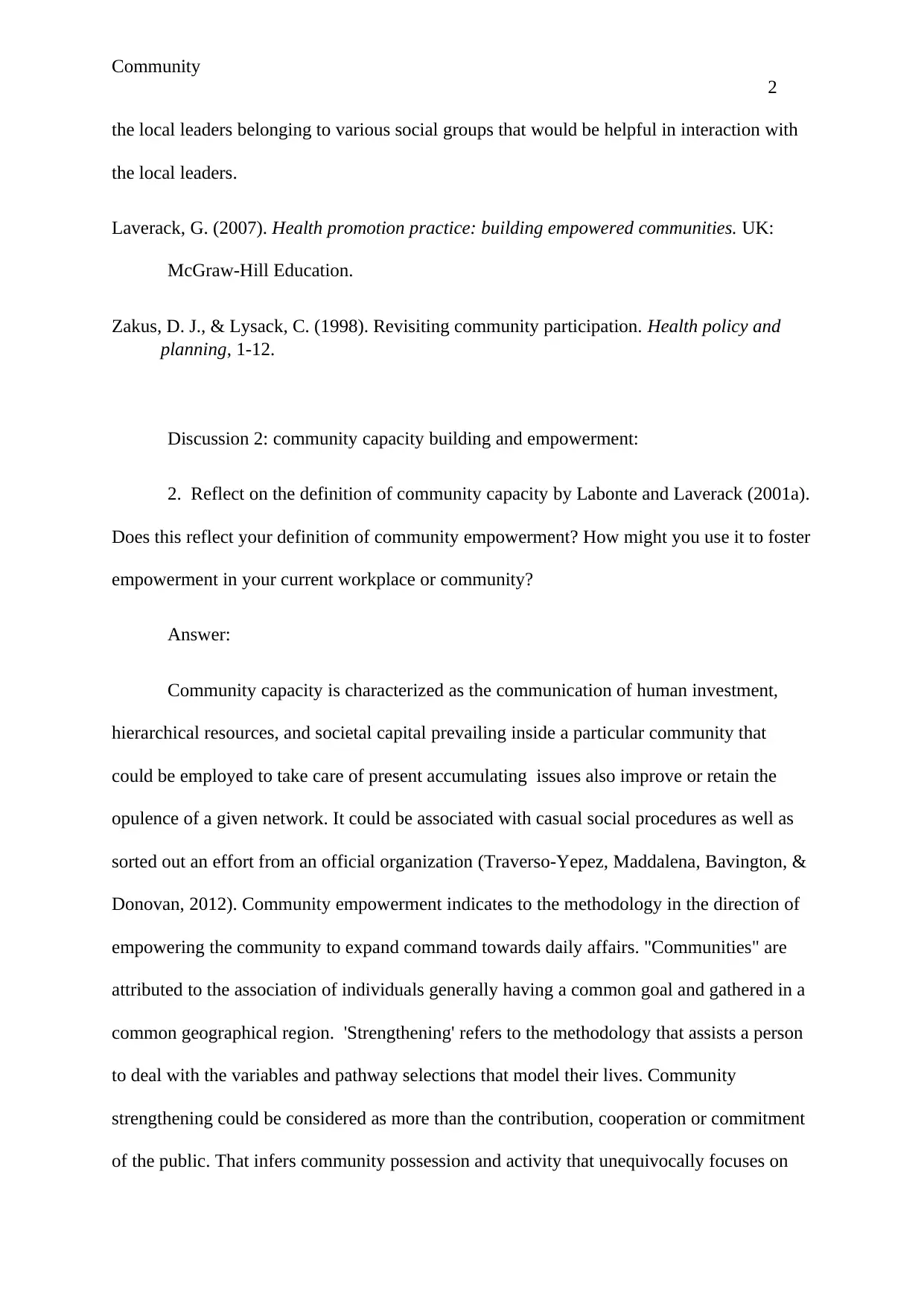
Community
2
the local leaders belonging to various social groups that would be helpful in interaction with
the local leaders.
Laverack, G. (2007). Health promotion practice: building empowered communities. UK:
McGraw-Hill Education.
Zakus, D. J., & Lysack, C. (1998). Revisiting community participation. Health policy and
planning, 1-12.
Discussion 2: community capacity building and empowerment:
2. Reflect on the definition of community capacity by Labonte and Laverack (2001a).
Does this reflect your definition of community empowerment? How might you use it to foster
empowerment in your current workplace or community?
Answer:
Community capacity is characterized as the communication of human investment,
hierarchical resources, and societal capital prevailing inside a particular community that
could be employed to take care of present accumulating issues also improve or retain the
opulence of a given network. It could be associated with casual social procedures as well as
sorted out an effort from an official organization (Traverso-Yepez, Maddalena, Bavington, &
Donovan, 2012). Community empowerment indicates to the methodology in the direction of
empowering the community to expand command towards daily affairs. "Communities" are
attributed to the association of individuals generally having a common goal and gathered in a
common geographical region. 'Strengthening' refers to the methodology that assists a person
to deal with the variables and pathway selections that model their lives. Community
strengthening could be considered as more than the contribution, cooperation or commitment
of the public. That infers community possession and activity that unequivocally focuses on
2
the local leaders belonging to various social groups that would be helpful in interaction with
the local leaders.
Laverack, G. (2007). Health promotion practice: building empowered communities. UK:
McGraw-Hill Education.
Zakus, D. J., & Lysack, C. (1998). Revisiting community participation. Health policy and
planning, 1-12.
Discussion 2: community capacity building and empowerment:
2. Reflect on the definition of community capacity by Labonte and Laverack (2001a).
Does this reflect your definition of community empowerment? How might you use it to foster
empowerment in your current workplace or community?
Answer:
Community capacity is characterized as the communication of human investment,
hierarchical resources, and societal capital prevailing inside a particular community that
could be employed to take care of present accumulating issues also improve or retain the
opulence of a given network. It could be associated with casual social procedures as well as
sorted out an effort from an official organization (Traverso-Yepez, Maddalena, Bavington, &
Donovan, 2012). Community empowerment indicates to the methodology in the direction of
empowering the community to expand command towards daily affairs. "Communities" are
attributed to the association of individuals generally having a common goal and gathered in a
common geographical region. 'Strengthening' refers to the methodology that assists a person
to deal with the variables and pathway selections that model their lives. Community
strengthening could be considered as more than the contribution, cooperation or commitment
of the public. That infers community possession and activity that unequivocally focuses on
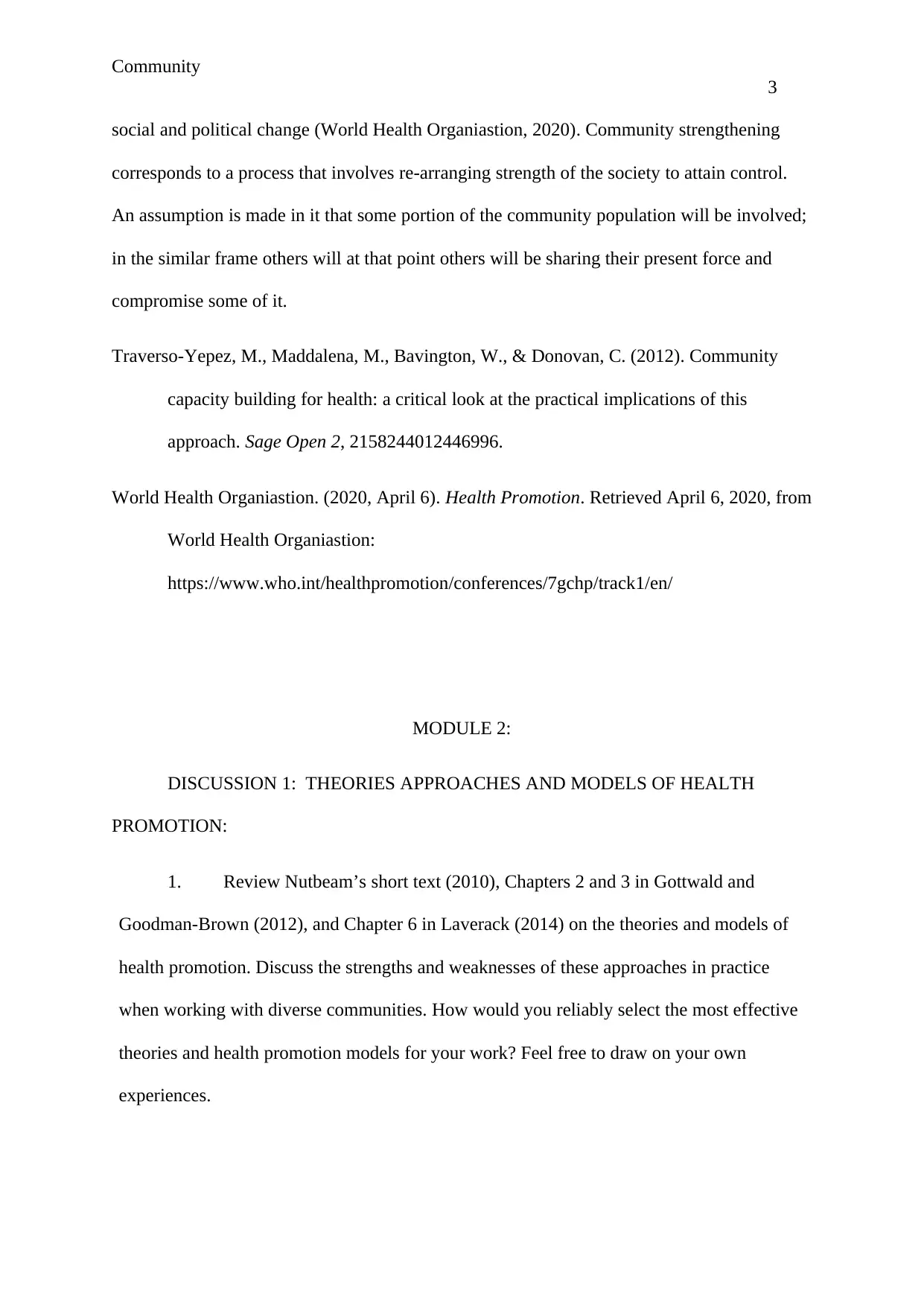
Community
3
social and political change (World Health Organiastion, 2020). Community strengthening
corresponds to a process that involves re-arranging strength of the society to attain control.
An assumption is made in it that some portion of the community population will be involved;
in the similar frame others will at that point others will be sharing their present force and
compromise some of it.
Traverso-Yepez, M., Maddalena, M., Bavington, W., & Donovan, C. (2012). Community
capacity building for health: a critical look at the practical implications of this
approach. Sage Open 2, 2158244012446996.
World Health Organiastion. (2020, April 6). Health Promotion. Retrieved April 6, 2020, from
World Health Organiastion:
https://www.who.int/healthpromotion/conferences/7gchp/track1/en/
MODULE 2:
DISCUSSION 1: THEORIES APPROACHES AND MODELS OF HEALTH
PROMOTION:
1. Review Nutbeam’s short text (2010), Chapters 2 and 3 in Gottwald and
Goodman-Brown (2012), and Chapter 6 in Laverack (2014) on the theories and models of
health promotion. Discuss the strengths and weaknesses of these approaches in practice
when working with diverse communities. How would you reliably select the most effective
theories and health promotion models for your work? Feel free to draw on your own
experiences.
3
social and political change (World Health Organiastion, 2020). Community strengthening
corresponds to a process that involves re-arranging strength of the society to attain control.
An assumption is made in it that some portion of the community population will be involved;
in the similar frame others will at that point others will be sharing their present force and
compromise some of it.
Traverso-Yepez, M., Maddalena, M., Bavington, W., & Donovan, C. (2012). Community
capacity building for health: a critical look at the practical implications of this
approach. Sage Open 2, 2158244012446996.
World Health Organiastion. (2020, April 6). Health Promotion. Retrieved April 6, 2020, from
World Health Organiastion:
https://www.who.int/healthpromotion/conferences/7gchp/track1/en/
MODULE 2:
DISCUSSION 1: THEORIES APPROACHES AND MODELS OF HEALTH
PROMOTION:
1. Review Nutbeam’s short text (2010), Chapters 2 and 3 in Gottwald and
Goodman-Brown (2012), and Chapter 6 in Laverack (2014) on the theories and models of
health promotion. Discuss the strengths and weaknesses of these approaches in practice
when working with diverse communities. How would you reliably select the most effective
theories and health promotion models for your work? Feel free to draw on your own
experiences.
Secure Best Marks with AI Grader
Need help grading? Try our AI Grader for instant feedback on your assignments.
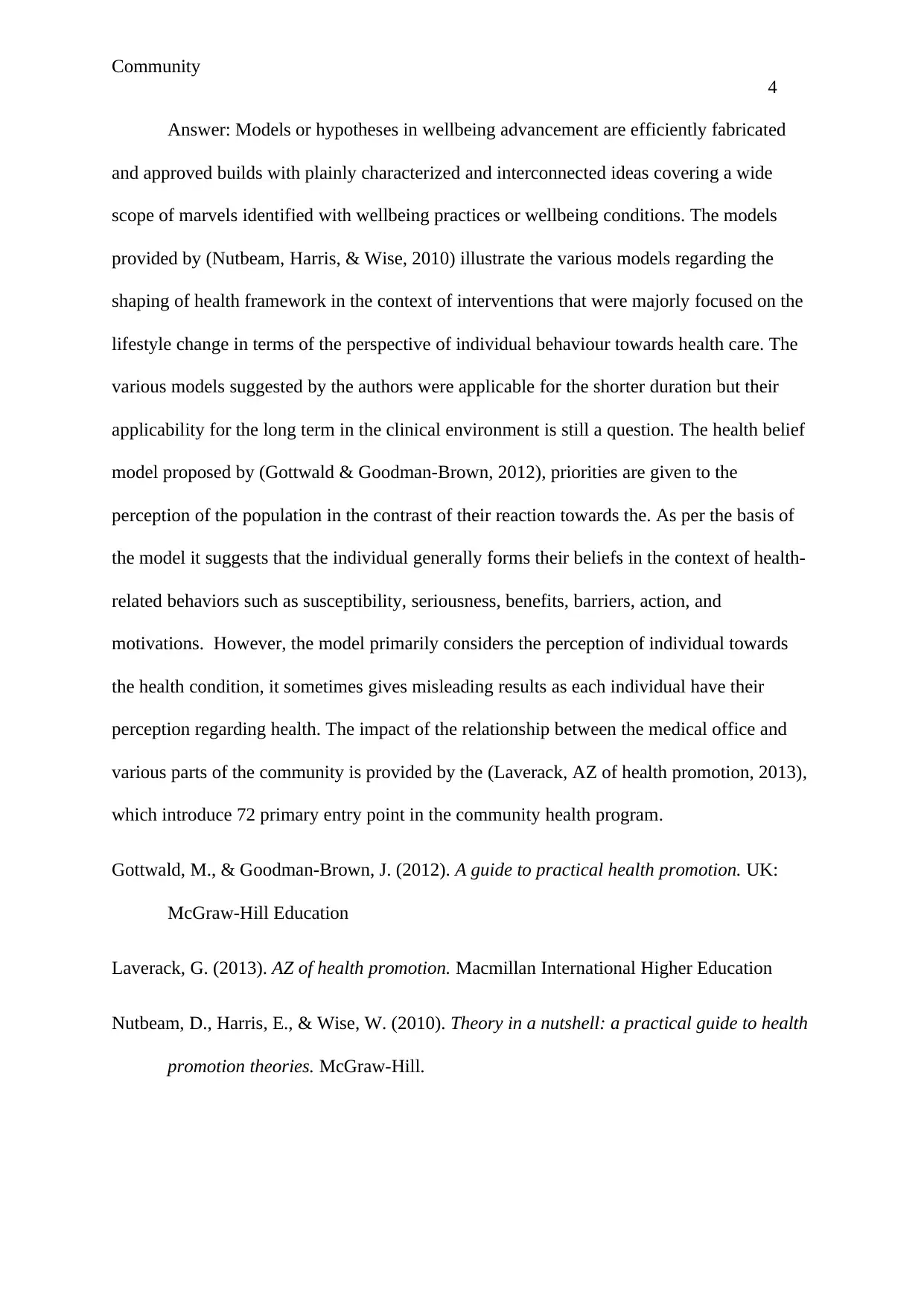
Community
4
Answer: Models or hypotheses in wellbeing advancement are efficiently fabricated
and approved builds with plainly characterized and interconnected ideas covering a wide
scope of marvels identified with wellbeing practices or wellbeing conditions. The models
provided by (Nutbeam, Harris, & Wise, 2010) illustrate the various models regarding the
shaping of health framework in the context of interventions that were majorly focused on the
lifestyle change in terms of the perspective of individual behaviour towards health care. The
various models suggested by the authors were applicable for the shorter duration but their
applicability for the long term in the clinical environment is still a question. The health belief
model proposed by (Gottwald & Goodman-Brown, 2012), priorities are given to the
perception of the population in the contrast of their reaction towards the. As per the basis of
the model it suggests that the individual generally forms their beliefs in the context of health-
related behaviors such as susceptibility, seriousness, benefits, barriers, action, and
motivations. However, the model primarily considers the perception of individual towards
the health condition, it sometimes gives misleading results as each individual have their
perception regarding health. The impact of the relationship between the medical office and
various parts of the community is provided by the (Laverack, AZ of health promotion, 2013),
which introduce 72 primary entry point in the community health program.
Gottwald, M., & Goodman-Brown, J. (2012). A guide to practical health promotion. UK:
McGraw-Hill Education
Laverack, G. (2013). AZ of health promotion. Macmillan International Higher Education
Nutbeam, D., Harris, E., & Wise, W. (2010). Theory in a nutshell: a practical guide to health
promotion theories. McGraw-Hill.
4
Answer: Models or hypotheses in wellbeing advancement are efficiently fabricated
and approved builds with plainly characterized and interconnected ideas covering a wide
scope of marvels identified with wellbeing practices or wellbeing conditions. The models
provided by (Nutbeam, Harris, & Wise, 2010) illustrate the various models regarding the
shaping of health framework in the context of interventions that were majorly focused on the
lifestyle change in terms of the perspective of individual behaviour towards health care. The
various models suggested by the authors were applicable for the shorter duration but their
applicability for the long term in the clinical environment is still a question. The health belief
model proposed by (Gottwald & Goodman-Brown, 2012), priorities are given to the
perception of the population in the contrast of their reaction towards the. As per the basis of
the model it suggests that the individual generally forms their beliefs in the context of health-
related behaviors such as susceptibility, seriousness, benefits, barriers, action, and
motivations. However, the model primarily considers the perception of individual towards
the health condition, it sometimes gives misleading results as each individual have their
perception regarding health. The impact of the relationship between the medical office and
various parts of the community is provided by the (Laverack, AZ of health promotion, 2013),
which introduce 72 primary entry point in the community health program.
Gottwald, M., & Goodman-Brown, J. (2012). A guide to practical health promotion. UK:
McGraw-Hill Education
Laverack, G. (2013). AZ of health promotion. Macmillan International Higher Education
Nutbeam, D., Harris, E., & Wise, W. (2010). Theory in a nutshell: a practical guide to health
promotion theories. McGraw-Hill.
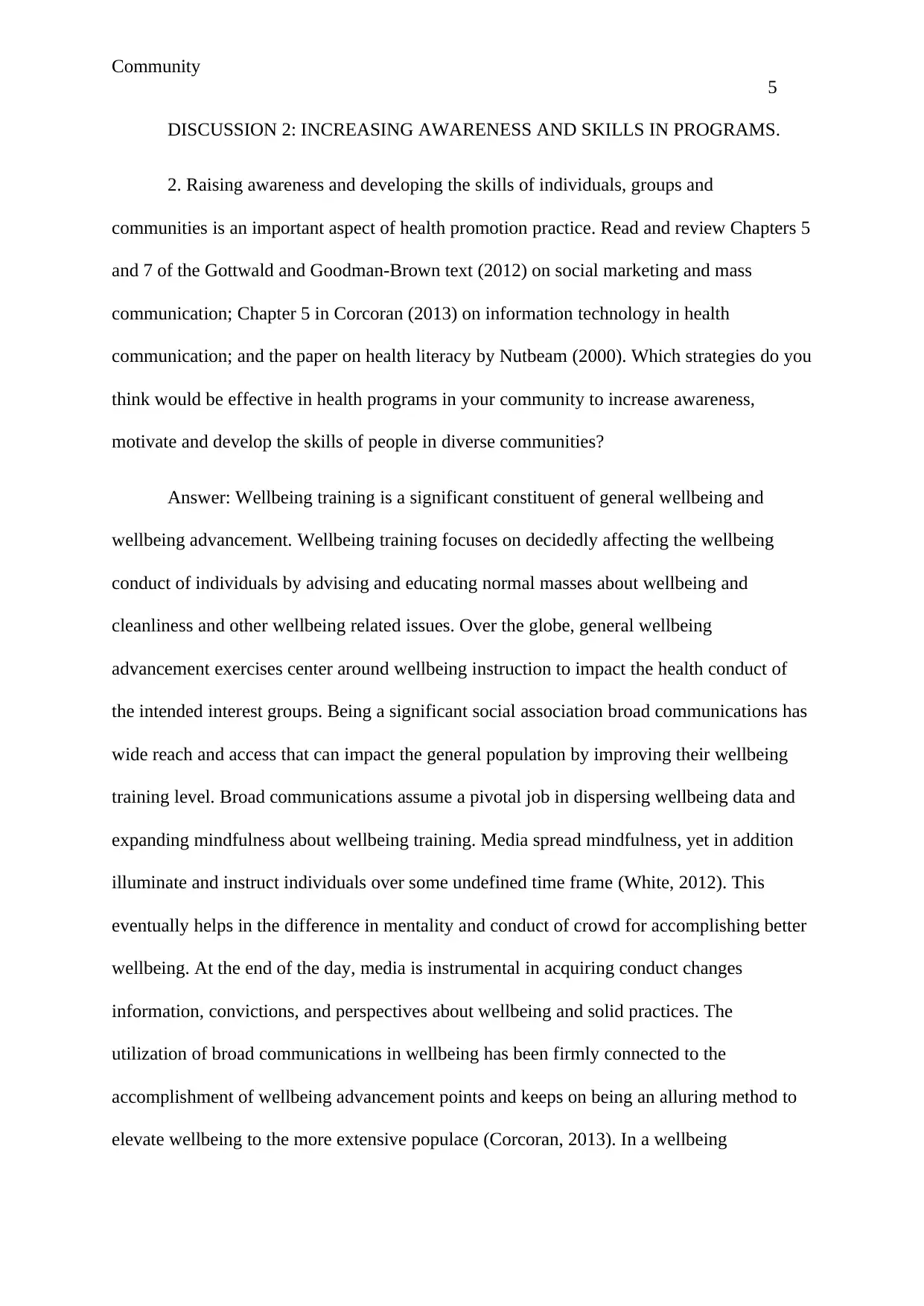
Community
5
DISCUSSION 2: INCREASING AWARENESS AND SKILLS IN PROGRAMS.
2. Raising awareness and developing the skills of individuals, groups and
communities is an important aspect of health promotion practice. Read and review Chapters 5
and 7 of the Gottwald and Goodman-Brown text (2012) on social marketing and mass
communication; Chapter 5 in Corcoran (2013) on information technology in health
communication; and the paper on health literacy by Nutbeam (2000). Which strategies do you
think would be effective in health programs in your community to increase awareness,
motivate and develop the skills of people in diverse communities?
Answer: Wellbeing training is a significant constituent of general wellbeing and
wellbeing advancement. Wellbeing training focuses on decidedly affecting the wellbeing
conduct of individuals by advising and educating normal masses about wellbeing and
cleanliness and other wellbeing related issues. Over the globe, general wellbeing
advancement exercises center around wellbeing instruction to impact the health conduct of
the intended interest groups. Being a significant social association broad communications has
wide reach and access that can impact the general population by improving their wellbeing
training level. Broad communications assume a pivotal job in dispersing wellbeing data and
expanding mindfulness about wellbeing training. Media spread mindfulness, yet in addition
illuminate and instruct individuals over some undefined time frame (White, 2012). This
eventually helps in the difference in mentality and conduct of crowd for accomplishing better
wellbeing. At the end of the day, media is instrumental in acquiring conduct changes
information, convictions, and perspectives about wellbeing and solid practices. The
utilization of broad communications in wellbeing has been firmly connected to the
accomplishment of wellbeing advancement points and keeps on being an alluring method to
elevate wellbeing to the more extensive populace (Corcoran, 2013). In a wellbeing
5
DISCUSSION 2: INCREASING AWARENESS AND SKILLS IN PROGRAMS.
2. Raising awareness and developing the skills of individuals, groups and
communities is an important aspect of health promotion practice. Read and review Chapters 5
and 7 of the Gottwald and Goodman-Brown text (2012) on social marketing and mass
communication; Chapter 5 in Corcoran (2013) on information technology in health
communication; and the paper on health literacy by Nutbeam (2000). Which strategies do you
think would be effective in health programs in your community to increase awareness,
motivate and develop the skills of people in diverse communities?
Answer: Wellbeing training is a significant constituent of general wellbeing and
wellbeing advancement. Wellbeing training focuses on decidedly affecting the wellbeing
conduct of individuals by advising and educating normal masses about wellbeing and
cleanliness and other wellbeing related issues. Over the globe, general wellbeing
advancement exercises center around wellbeing instruction to impact the health conduct of
the intended interest groups. Being a significant social association broad communications has
wide reach and access that can impact the general population by improving their wellbeing
training level. Broad communications assume a pivotal job in dispersing wellbeing data and
expanding mindfulness about wellbeing training. Media spread mindfulness, yet in addition
illuminate and instruct individuals over some undefined time frame (White, 2012). This
eventually helps in the difference in mentality and conduct of crowd for accomplishing better
wellbeing. At the end of the day, media is instrumental in acquiring conduct changes
information, convictions, and perspectives about wellbeing and solid practices. The
utilization of broad communications in wellbeing has been firmly connected to the
accomplishment of wellbeing advancement points and keeps on being an alluring method to
elevate wellbeing to the more extensive populace (Corcoran, 2013). In a wellbeing
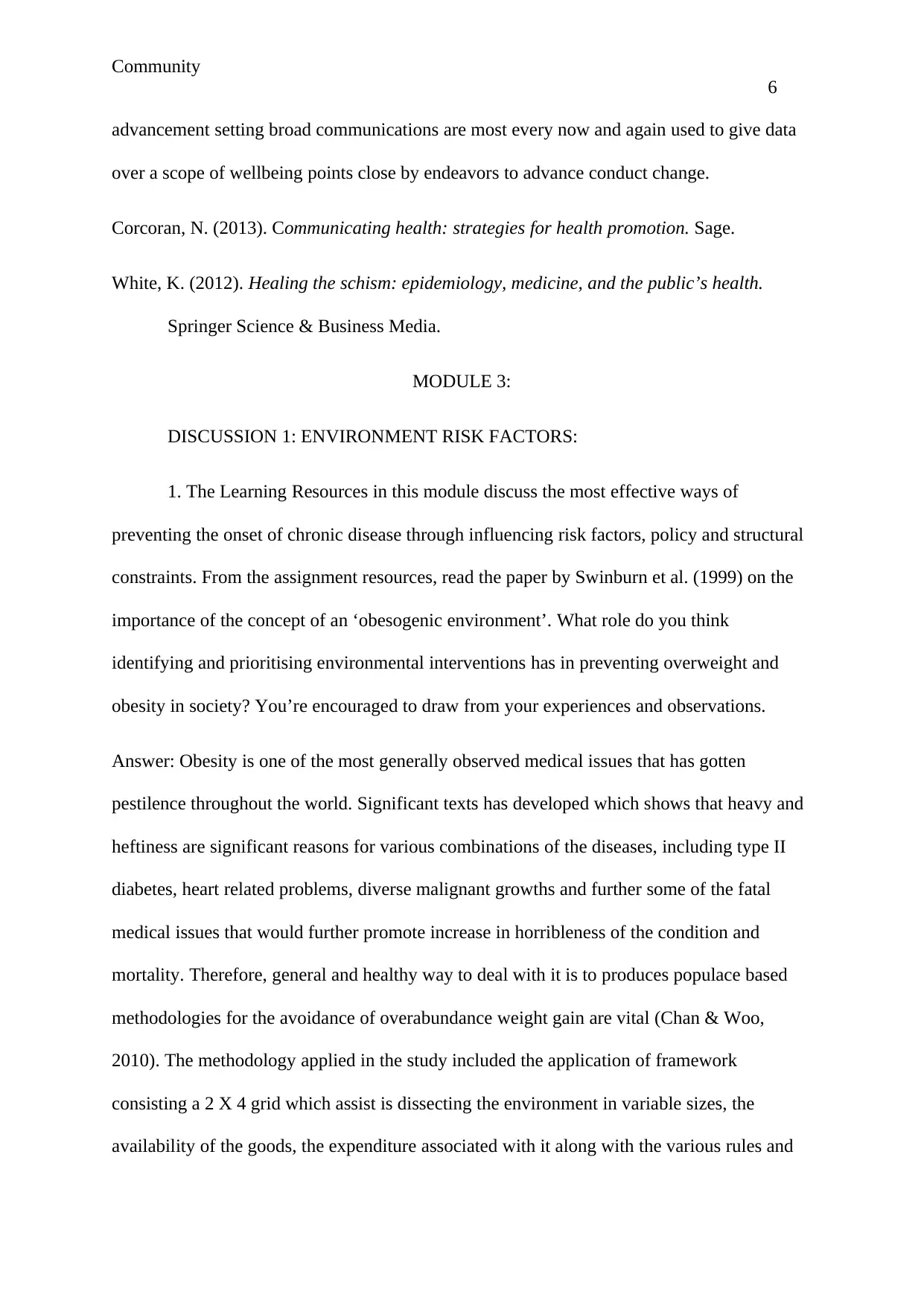
Community
6
advancement setting broad communications are most every now and again used to give data
over a scope of wellbeing points close by endeavors to advance conduct change.
Corcoran, N. (2013). Communicating health: strategies for health promotion. Sage.
White, K. (2012). Healing the schism: epidemiology, medicine, and the public’s health.
Springer Science & Business Media.
MODULE 3:
DISCUSSION 1: ENVIRONMENT RISK FACTORS:
1. The Learning Resources in this module discuss the most effective ways of
preventing the onset of chronic disease through influencing risk factors, policy and structural
constraints. From the assignment resources, read the paper by Swinburn et al. (1999) on the
importance of the concept of an ‘obesogenic environment’. What role do you think
identifying and prioritising environmental interventions has in preventing overweight and
obesity in society? You’re encouraged to draw from your experiences and observations.
Answer: Obesity is one of the most generally observed medical issues that has gotten
pestilence throughout the world. Significant texts has developed which shows that heavy and
heftiness are significant reasons for various combinations of the diseases, including type II
diabetes, heart related problems, diverse malignant growths and further some of the fatal
medical issues that would further promote increase in horribleness of the condition and
mortality. Therefore, general and healthy way to deal with it is to produces populace based
methodologies for the avoidance of overabundance weight gain are vital (Chan & Woo,
2010). The methodology applied in the study included the application of framework
consisting a 2 X 4 grid which assist is dissecting the environment in variable sizes, the
availability of the goods, the expenditure associated with it along with the various rules and
6
advancement setting broad communications are most every now and again used to give data
over a scope of wellbeing points close by endeavors to advance conduct change.
Corcoran, N. (2013). Communicating health: strategies for health promotion. Sage.
White, K. (2012). Healing the schism: epidemiology, medicine, and the public’s health.
Springer Science & Business Media.
MODULE 3:
DISCUSSION 1: ENVIRONMENT RISK FACTORS:
1. The Learning Resources in this module discuss the most effective ways of
preventing the onset of chronic disease through influencing risk factors, policy and structural
constraints. From the assignment resources, read the paper by Swinburn et al. (1999) on the
importance of the concept of an ‘obesogenic environment’. What role do you think
identifying and prioritising environmental interventions has in preventing overweight and
obesity in society? You’re encouraged to draw from your experiences and observations.
Answer: Obesity is one of the most generally observed medical issues that has gotten
pestilence throughout the world. Significant texts has developed which shows that heavy and
heftiness are significant reasons for various combinations of the diseases, including type II
diabetes, heart related problems, diverse malignant growths and further some of the fatal
medical issues that would further promote increase in horribleness of the condition and
mortality. Therefore, general and healthy way to deal with it is to produces populace based
methodologies for the avoidance of overabundance weight gain are vital (Chan & Woo,
2010). The methodology applied in the study included the application of framework
consisting a 2 X 4 grid which assist is dissecting the environment in variable sizes, the
availability of the goods, the expenditure associated with it along with the various rules and
Paraphrase This Document
Need a fresh take? Get an instant paraphrase of this document with our AI Paraphraser
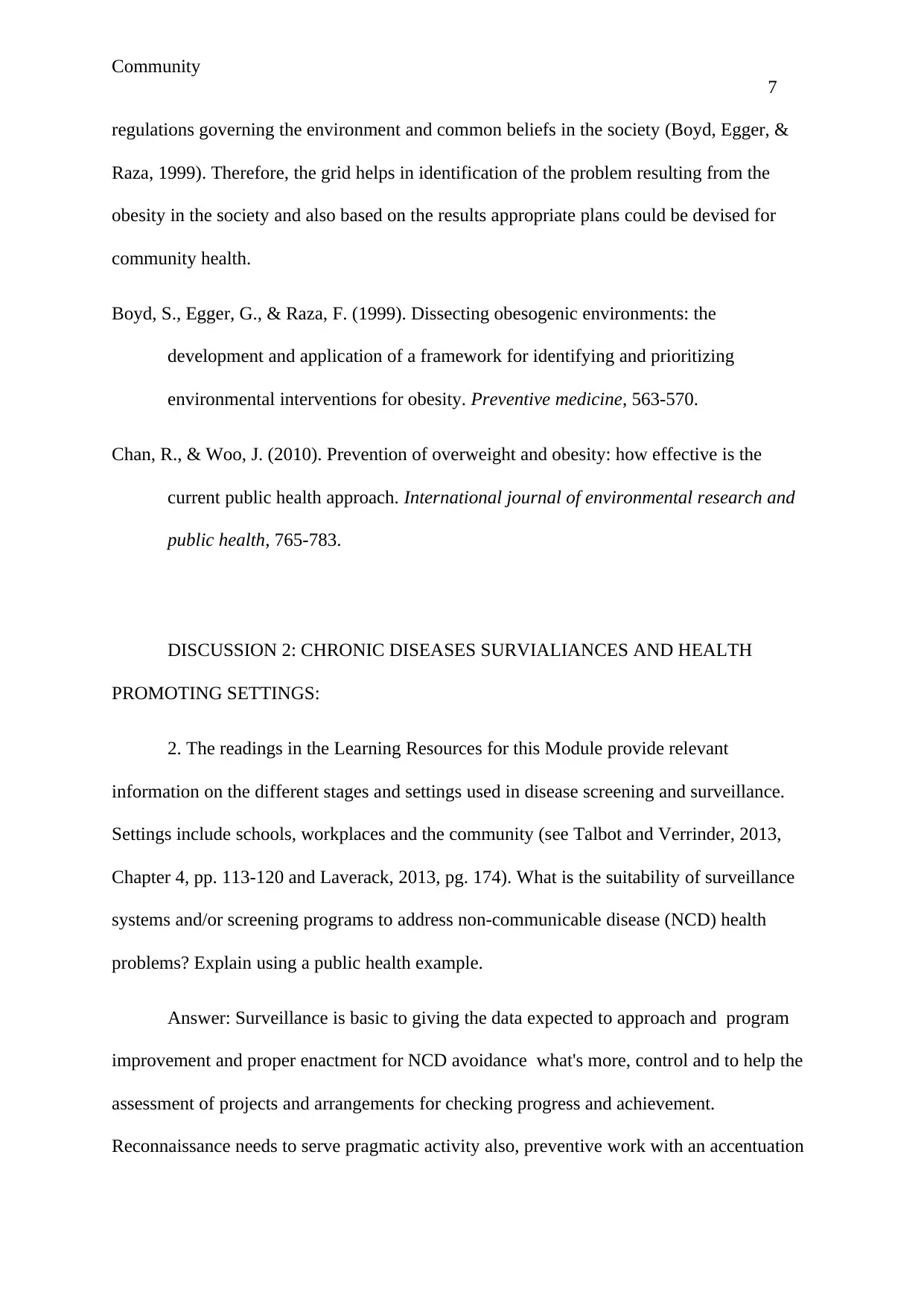
Community
7
regulations governing the environment and common beliefs in the society (Boyd, Egger, &
Raza, 1999). Therefore, the grid helps in identification of the problem resulting from the
obesity in the society and also based on the results appropriate plans could be devised for
community health.
Boyd, S., Egger, G., & Raza, F. (1999). Dissecting obesogenic environments: the
development and application of a framework for identifying and prioritizing
environmental interventions for obesity. Preventive medicine, 563-570.
Chan, R., & Woo, J. (2010). Prevention of overweight and obesity: how effective is the
current public health approach. International journal of environmental research and
public health, 765-783.
DISCUSSION 2: CHRONIC DISEASES SURVIALIANCES AND HEALTH
PROMOTING SETTINGS:
2. The readings in the Learning Resources for this Module provide relevant
information on the different stages and settings used in disease screening and surveillance.
Settings include schools, workplaces and the community (see Talbot and Verrinder, 2013,
Chapter 4, pp. 113-120 and Laverack, 2013, pg. 174). What is the suitability of surveillance
systems and/or screening programs to address non-communicable disease (NCD) health
problems? Explain using a public health example.
Answer: Surveillance is basic to giving the data expected to approach and program
improvement and proper enactment for NCD avoidance what's more, control and to help the
assessment of projects and arrangements for checking progress and achievement.
Reconnaissance needs to serve pragmatic activity also, preventive work with an accentuation
7
regulations governing the environment and common beliefs in the society (Boyd, Egger, &
Raza, 1999). Therefore, the grid helps in identification of the problem resulting from the
obesity in the society and also based on the results appropriate plans could be devised for
community health.
Boyd, S., Egger, G., & Raza, F. (1999). Dissecting obesogenic environments: the
development and application of a framework for identifying and prioritizing
environmental interventions for obesity. Preventive medicine, 563-570.
Chan, R., & Woo, J. (2010). Prevention of overweight and obesity: how effective is the
current public health approach. International journal of environmental research and
public health, 765-783.
DISCUSSION 2: CHRONIC DISEASES SURVIALIANCES AND HEALTH
PROMOTING SETTINGS:
2. The readings in the Learning Resources for this Module provide relevant
information on the different stages and settings used in disease screening and surveillance.
Settings include schools, workplaces and the community (see Talbot and Verrinder, 2013,
Chapter 4, pp. 113-120 and Laverack, 2013, pg. 174). What is the suitability of surveillance
systems and/or screening programs to address non-communicable disease (NCD) health
problems? Explain using a public health example.
Answer: Surveillance is basic to giving the data expected to approach and program
improvement and proper enactment for NCD avoidance what's more, control and to help the
assessment of projects and arrangements for checking progress and achievement.
Reconnaissance needs to serve pragmatic activity also, preventive work with an accentuation
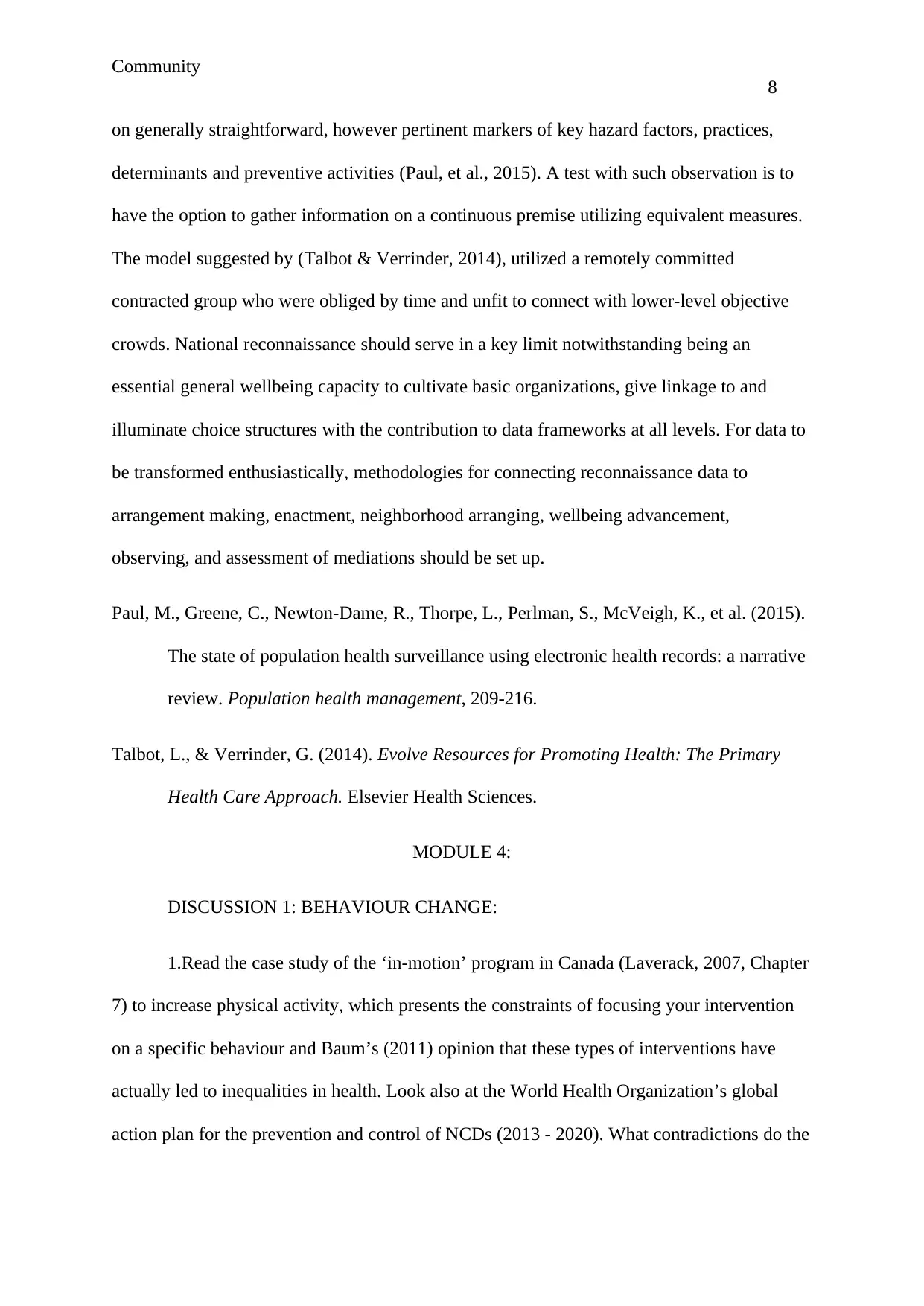
Community
8
on generally straightforward, however pertinent markers of key hazard factors, practices,
determinants and preventive activities (Paul, et al., 2015). A test with such observation is to
have the option to gather information on a continuous premise utilizing equivalent measures.
The model suggested by (Talbot & Verrinder, 2014), utilized a remotely committed
contracted group who were obliged by time and unfit to connect with lower-level objective
crowds. National reconnaissance should serve in a key limit notwithstanding being an
essential general wellbeing capacity to cultivate basic organizations, give linkage to and
illuminate choice structures with the contribution to data frameworks at all levels. For data to
be transformed enthusiastically, methodologies for connecting reconnaissance data to
arrangement making, enactment, neighborhood arranging, wellbeing advancement,
observing, and assessment of mediations should be set up.
Paul, M., Greene, C., Newton-Dame, R., Thorpe, L., Perlman, S., McVeigh, K., et al. (2015).
The state of population health surveillance using electronic health records: a narrative
review. Population health management, 209-216.
Talbot, L., & Verrinder, G. (2014). Evolve Resources for Promoting Health: The Primary
Health Care Approach. Elsevier Health Sciences.
MODULE 4:
DISCUSSION 1: BEHAVIOUR CHANGE:
1.Read the case study of the ‘in-motion’ program in Canada (Laverack, 2007, Chapter
7) to increase physical activity, which presents the constraints of focusing your intervention
on a specific behaviour and Baum’s (2011) opinion that these types of interventions have
actually led to inequalities in health. Look also at the World Health Organization’s global
action plan for the prevention and control of NCDs (2013 - 2020). What contradictions do the
8
on generally straightforward, however pertinent markers of key hazard factors, practices,
determinants and preventive activities (Paul, et al., 2015). A test with such observation is to
have the option to gather information on a continuous premise utilizing equivalent measures.
The model suggested by (Talbot & Verrinder, 2014), utilized a remotely committed
contracted group who were obliged by time and unfit to connect with lower-level objective
crowds. National reconnaissance should serve in a key limit notwithstanding being an
essential general wellbeing capacity to cultivate basic organizations, give linkage to and
illuminate choice structures with the contribution to data frameworks at all levels. For data to
be transformed enthusiastically, methodologies for connecting reconnaissance data to
arrangement making, enactment, neighborhood arranging, wellbeing advancement,
observing, and assessment of mediations should be set up.
Paul, M., Greene, C., Newton-Dame, R., Thorpe, L., Perlman, S., McVeigh, K., et al. (2015).
The state of population health surveillance using electronic health records: a narrative
review. Population health management, 209-216.
Talbot, L., & Verrinder, G. (2014). Evolve Resources for Promoting Health: The Primary
Health Care Approach. Elsevier Health Sciences.
MODULE 4:
DISCUSSION 1: BEHAVIOUR CHANGE:
1.Read the case study of the ‘in-motion’ program in Canada (Laverack, 2007, Chapter
7) to increase physical activity, which presents the constraints of focusing your intervention
on a specific behaviour and Baum’s (2011) opinion that these types of interventions have
actually led to inequalities in health. Look also at the World Health Organization’s global
action plan for the prevention and control of NCDs (2013 - 2020). What contradictions do the
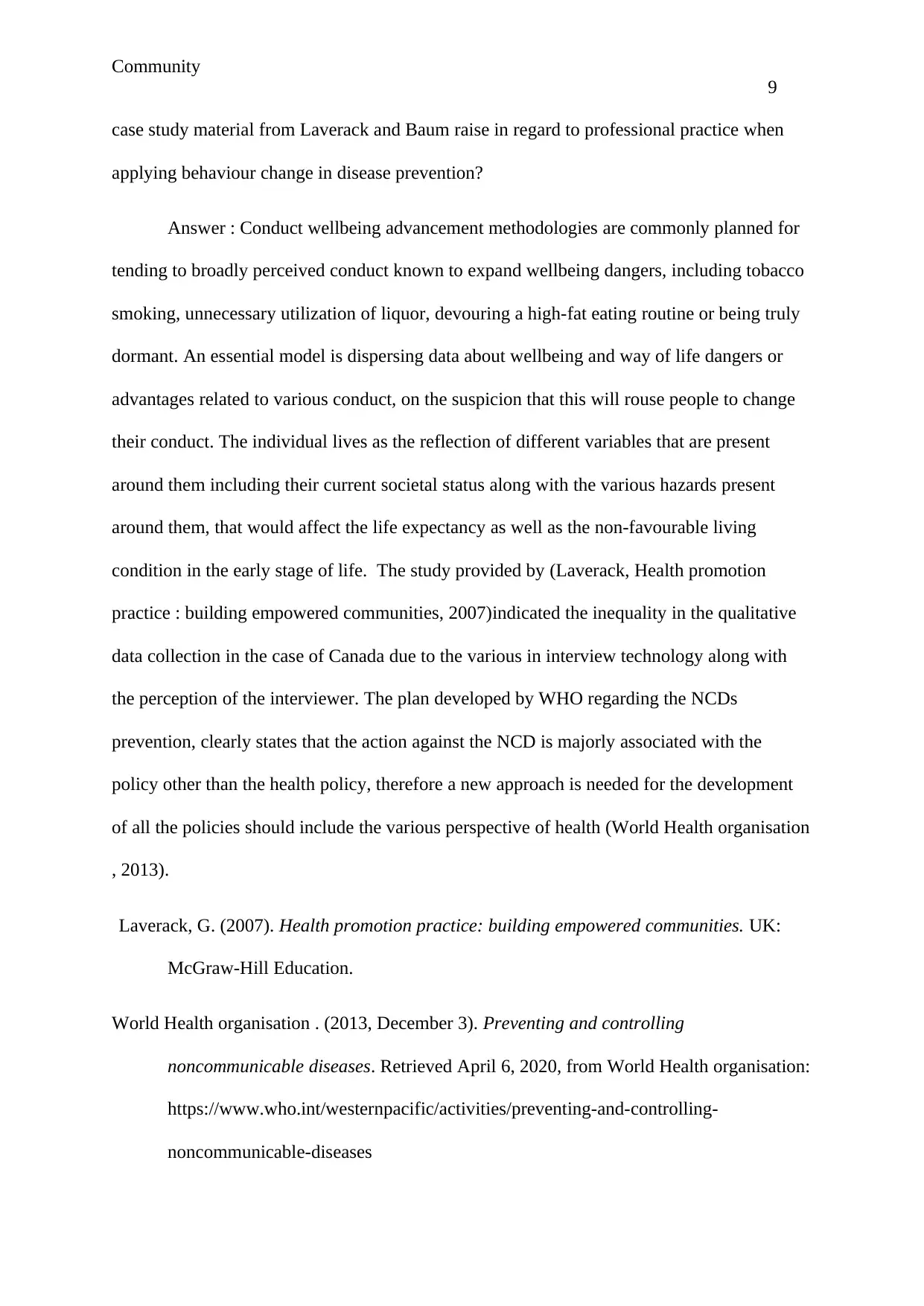
Community
9
case study material from Laverack and Baum raise in regard to professional practice when
applying behaviour change in disease prevention?
Answer : Conduct wellbeing advancement methodologies are commonly planned for
tending to broadly perceived conduct known to expand wellbeing dangers, including tobacco
smoking, unnecessary utilization of liquor, devouring a high-fat eating routine or being truly
dormant. An essential model is dispersing data about wellbeing and way of life dangers or
advantages related to various conduct, on the suspicion that this will rouse people to change
their conduct. The individual lives as the reflection of different variables that are present
around them including their current societal status along with the various hazards present
around them, that would affect the life expectancy as well as the non-favourable living
condition in the early stage of life. The study provided by (Laverack, Health promotion
practice : building empowered communities, 2007)indicated the inequality in the qualitative
data collection in the case of Canada due to the various in interview technology along with
the perception of the interviewer. The plan developed by WHO regarding the NCDs
prevention, clearly states that the action against the NCD is majorly associated with the
policy other than the health policy, therefore a new approach is needed for the development
of all the policies should include the various perspective of health (World Health organisation
, 2013).
Laverack, G. (2007). Health promotion practice: building empowered communities. UK:
McGraw-Hill Education.
World Health organisation . (2013, December 3). Preventing and controlling
noncommunicable diseases. Retrieved April 6, 2020, from World Health organisation:
https://www.who.int/westernpacific/activities/preventing-and-controlling-
noncommunicable-diseases
9
case study material from Laverack and Baum raise in regard to professional practice when
applying behaviour change in disease prevention?
Answer : Conduct wellbeing advancement methodologies are commonly planned for
tending to broadly perceived conduct known to expand wellbeing dangers, including tobacco
smoking, unnecessary utilization of liquor, devouring a high-fat eating routine or being truly
dormant. An essential model is dispersing data about wellbeing and way of life dangers or
advantages related to various conduct, on the suspicion that this will rouse people to change
their conduct. The individual lives as the reflection of different variables that are present
around them including their current societal status along with the various hazards present
around them, that would affect the life expectancy as well as the non-favourable living
condition in the early stage of life. The study provided by (Laverack, Health promotion
practice : building empowered communities, 2007)indicated the inequality in the qualitative
data collection in the case of Canada due to the various in interview technology along with
the perception of the interviewer. The plan developed by WHO regarding the NCDs
prevention, clearly states that the action against the NCD is majorly associated with the
policy other than the health policy, therefore a new approach is needed for the development
of all the policies should include the various perspective of health (World Health organisation
, 2013).
Laverack, G. (2007). Health promotion practice: building empowered communities. UK:
McGraw-Hill Education.
World Health organisation . (2013, December 3). Preventing and controlling
noncommunicable diseases. Retrieved April 6, 2020, from World Health organisation:
https://www.who.int/westernpacific/activities/preventing-and-controlling-
noncommunicable-diseases
Secure Best Marks with AI Grader
Need help grading? Try our AI Grader for instant feedback on your assignments.
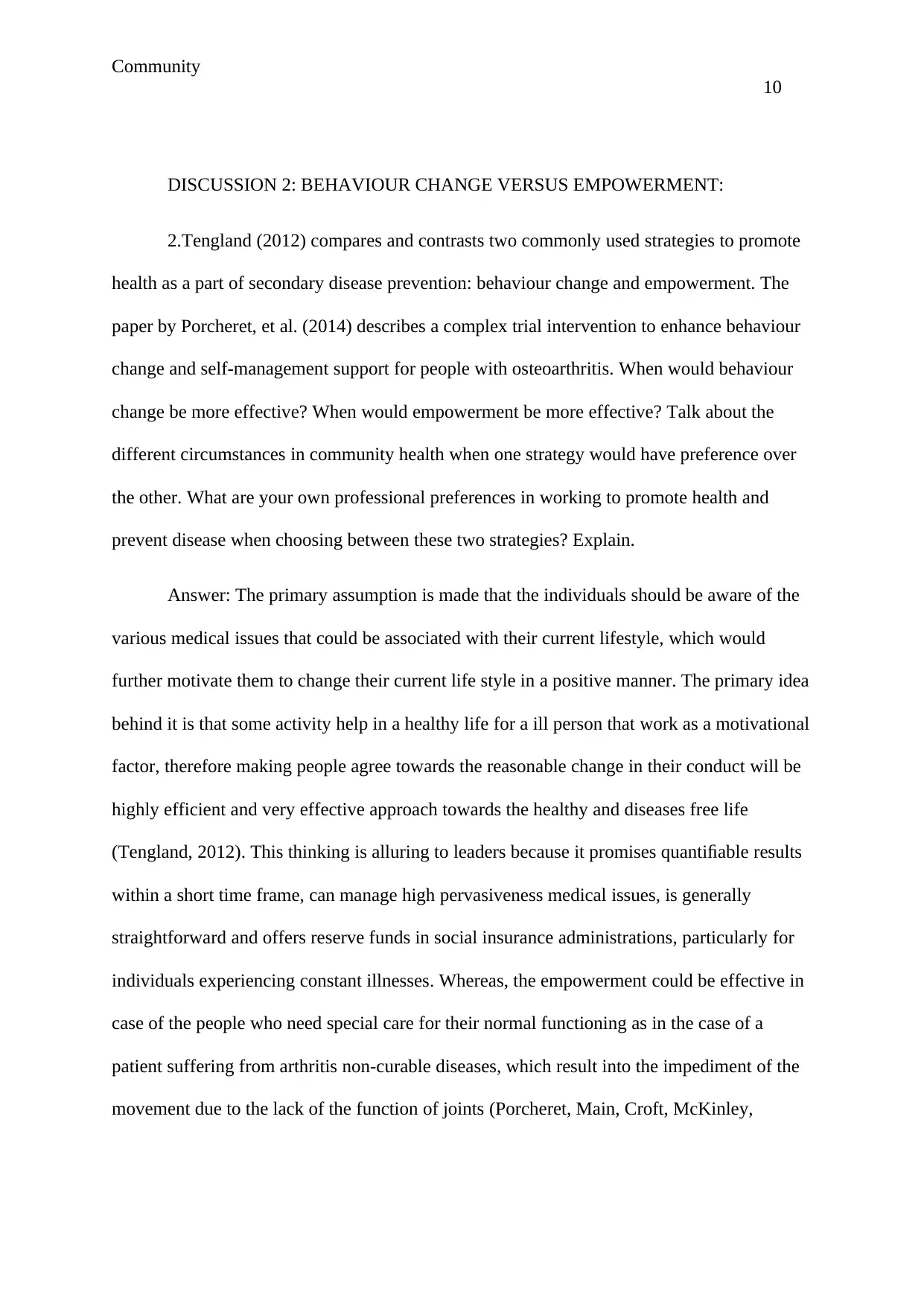
Community
10
DISCUSSION 2: BEHAVIOUR CHANGE VERSUS EMPOWERMENT:
2.Tengland (2012) compares and contrasts two commonly used strategies to promote
health as a part of secondary disease prevention: behaviour change and empowerment. The
paper by Porcheret, et al. (2014) describes a complex trial intervention to enhance behaviour
change and self-management support for people with osteoarthritis. When would behaviour
change be more effective? When would empowerment be more effective? Talk about the
different circumstances in community health when one strategy would have preference over
the other. What are your own professional preferences in working to promote health and
prevent disease when choosing between these two strategies? Explain.
Answer: The primary assumption is made that the individuals should be aware of the
various medical issues that could be associated with their current lifestyle, which would
further motivate them to change their current life style in a positive manner. The primary idea
behind it is that some activity help in a healthy life for a ill person that work as a motivational
factor, therefore making people agree towards the reasonable change in their conduct will be
highly efficient and very effective approach towards the healthy and diseases free life
(Tengland, 2012). This thinking is alluring to leaders because it promises quantifiable results
within a short time frame, can manage high pervasiveness medical issues, is generally
straightforward and offers reserve funds in social insurance administrations, particularly for
individuals experiencing constant illnesses. Whereas, the empowerment could be effective in
case of the people who need special care for their normal functioning as in the case of a
patient suffering from arthritis non-curable diseases, which result into the impediment of the
movement due to the lack of the function of joints (Porcheret, Main, Croft, McKinley,
10
DISCUSSION 2: BEHAVIOUR CHANGE VERSUS EMPOWERMENT:
2.Tengland (2012) compares and contrasts two commonly used strategies to promote
health as a part of secondary disease prevention: behaviour change and empowerment. The
paper by Porcheret, et al. (2014) describes a complex trial intervention to enhance behaviour
change and self-management support for people with osteoarthritis. When would behaviour
change be more effective? When would empowerment be more effective? Talk about the
different circumstances in community health when one strategy would have preference over
the other. What are your own professional preferences in working to promote health and
prevent disease when choosing between these two strategies? Explain.
Answer: The primary assumption is made that the individuals should be aware of the
various medical issues that could be associated with their current lifestyle, which would
further motivate them to change their current life style in a positive manner. The primary idea
behind it is that some activity help in a healthy life for a ill person that work as a motivational
factor, therefore making people agree towards the reasonable change in their conduct will be
highly efficient and very effective approach towards the healthy and diseases free life
(Tengland, 2012). This thinking is alluring to leaders because it promises quantifiable results
within a short time frame, can manage high pervasiveness medical issues, is generally
straightforward and offers reserve funds in social insurance administrations, particularly for
individuals experiencing constant illnesses. Whereas, the empowerment could be effective in
case of the people who need special care for their normal functioning as in the case of a
patient suffering from arthritis non-curable diseases, which result into the impediment of the
movement due to the lack of the function of joints (Porcheret, Main, Croft, McKinley,
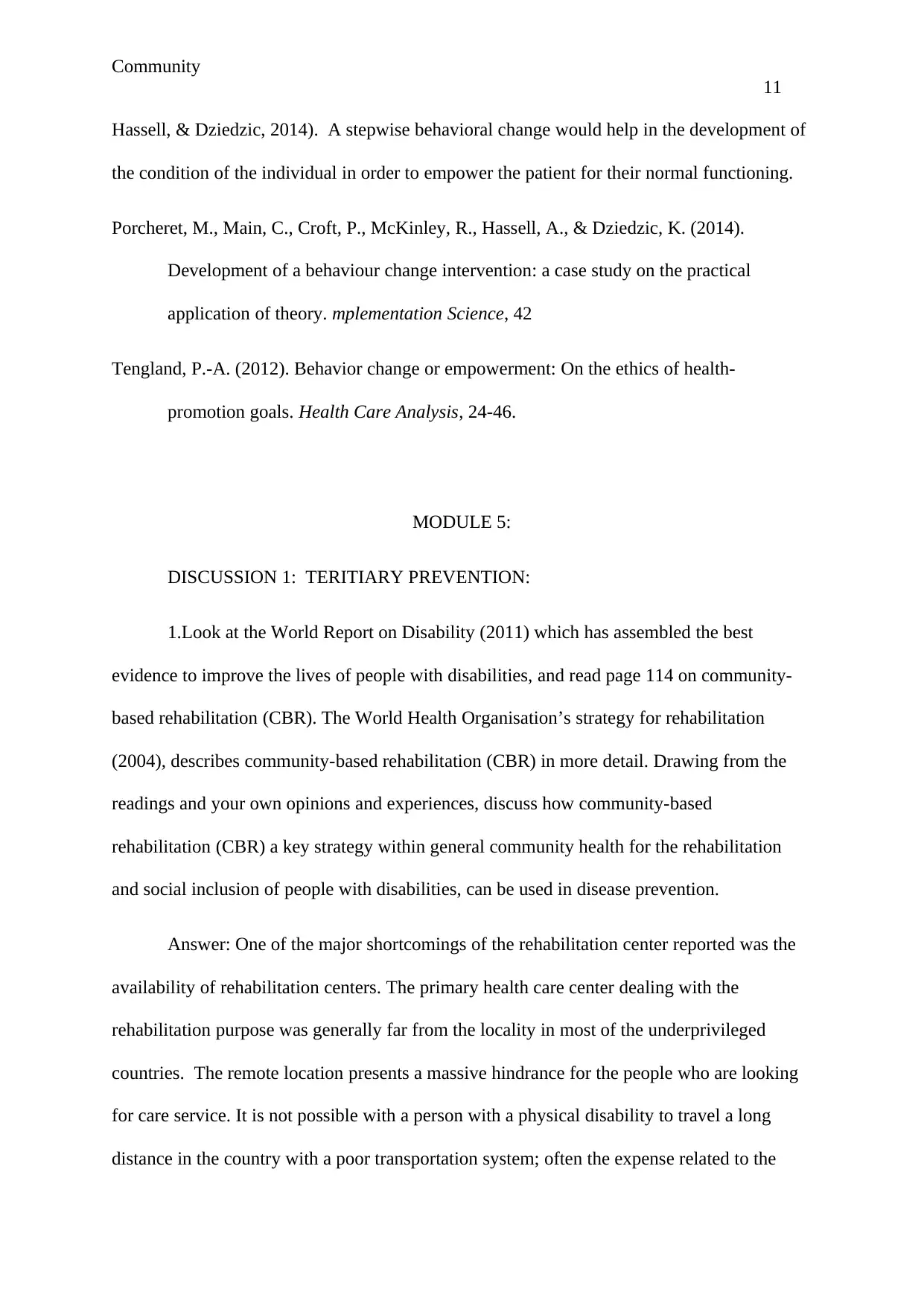
Community
11
Hassell, & Dziedzic, 2014). A stepwise behavioral change would help in the development of
the condition of the individual in order to empower the patient for their normal functioning.
Porcheret, M., Main, C., Croft, P., McKinley, R., Hassell, A., & Dziedzic, K. (2014).
Development of a behaviour change intervention: a case study on the practical
application of theory. mplementation Science, 42
Tengland, P.-A. (2012). Behavior change or empowerment: On the ethics of health-
promotion goals. Health Care Analysis, 24-46.
MODULE 5:
DISCUSSION 1: TERITIARY PREVENTION:
1.Look at the World Report on Disability (2011) which has assembled the best
evidence to improve the lives of people with disabilities, and read page 114 on community-
based rehabilitation (CBR). The World Health Organisation’s strategy for rehabilitation
(2004), describes community-based rehabilitation (CBR) in more detail. Drawing from the
readings and your own opinions and experiences, discuss how community-based
rehabilitation (CBR) a key strategy within general community health for the rehabilitation
and social inclusion of people with disabilities, can be used in disease prevention.
Answer: One of the major shortcomings of the rehabilitation center reported was the
availability of rehabilitation centers. The primary health care center dealing with the
rehabilitation purpose was generally far from the locality in most of the underprivileged
countries. The remote location presents a massive hindrance for the people who are looking
for care service. It is not possible with a person with a physical disability to travel a long
distance in the country with a poor transportation system; often the expense related to the
11
Hassell, & Dziedzic, 2014). A stepwise behavioral change would help in the development of
the condition of the individual in order to empower the patient for their normal functioning.
Porcheret, M., Main, C., Croft, P., McKinley, R., Hassell, A., & Dziedzic, K. (2014).
Development of a behaviour change intervention: a case study on the practical
application of theory. mplementation Science, 42
Tengland, P.-A. (2012). Behavior change or empowerment: On the ethics of health-
promotion goals. Health Care Analysis, 24-46.
MODULE 5:
DISCUSSION 1: TERITIARY PREVENTION:
1.Look at the World Report on Disability (2011) which has assembled the best
evidence to improve the lives of people with disabilities, and read page 114 on community-
based rehabilitation (CBR). The World Health Organisation’s strategy for rehabilitation
(2004), describes community-based rehabilitation (CBR) in more detail. Drawing from the
readings and your own opinions and experiences, discuss how community-based
rehabilitation (CBR) a key strategy within general community health for the rehabilitation
and social inclusion of people with disabilities, can be used in disease prevention.
Answer: One of the major shortcomings of the rehabilitation center reported was the
availability of rehabilitation centers. The primary health care center dealing with the
rehabilitation purpose was generally far from the locality in most of the underprivileged
countries. The remote location presents a massive hindrance for the people who are looking
for care service. It is not possible with a person with a physical disability to travel a long
distance in the country with a poor transportation system; often the expense related to the
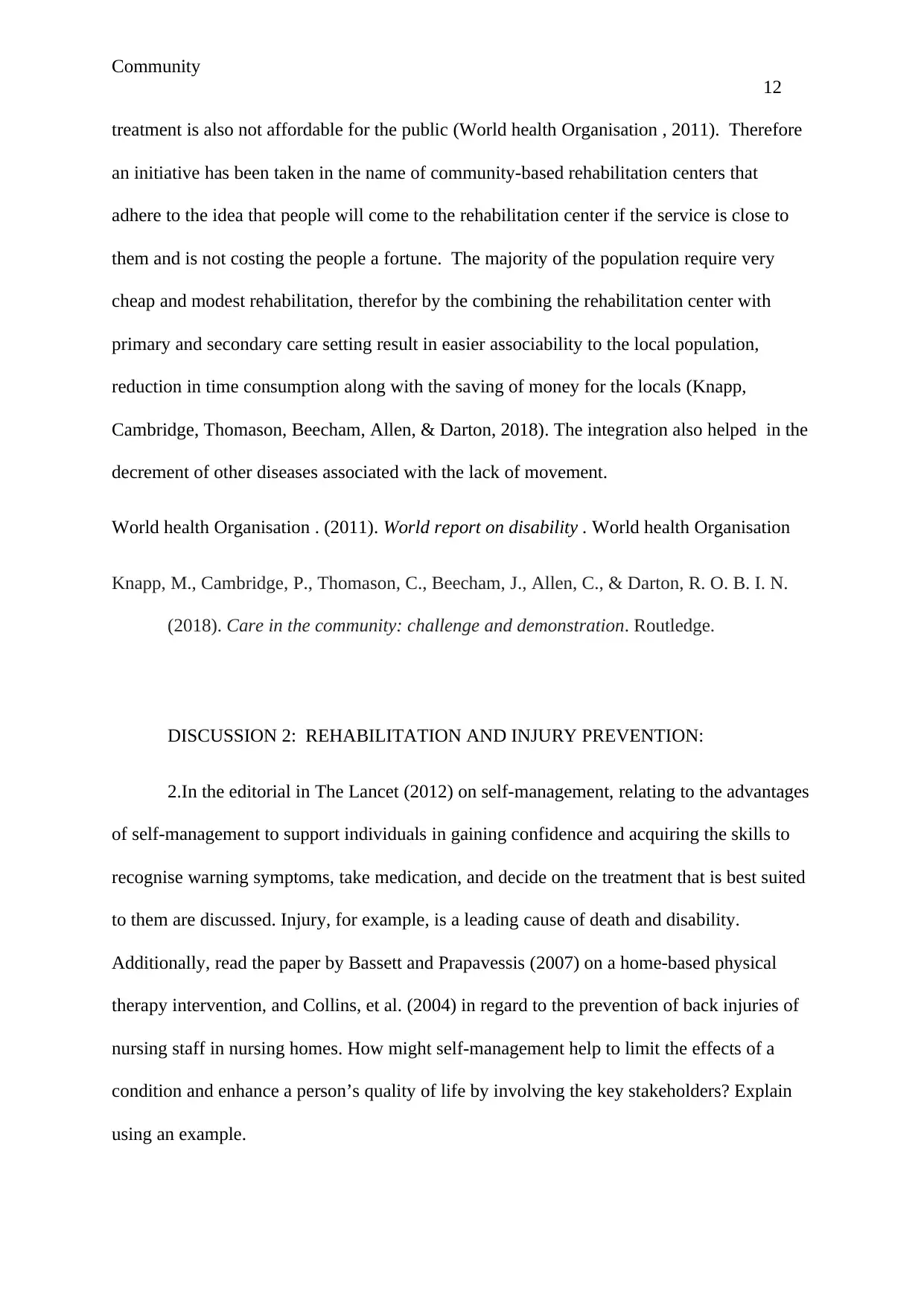
Community
12
treatment is also not affordable for the public (World health Organisation , 2011). Therefore
an initiative has been taken in the name of community-based rehabilitation centers that
adhere to the idea that people will come to the rehabilitation center if the service is close to
them and is not costing the people a fortune. The majority of the population require very
cheap and modest rehabilitation, therefor by the combining the rehabilitation center with
primary and secondary care setting result in easier associability to the local population,
reduction in time consumption along with the saving of money for the locals (Knapp,
Cambridge, Thomason, Beecham, Allen, & Darton, 2018). The integration also helped in the
decrement of other diseases associated with the lack of movement.
World health Organisation . (2011). World report on disability . World health Organisation
Knapp, M., Cambridge, P., Thomason, C., Beecham, J., Allen, C., & Darton, R. O. B. I. N.
(2018). Care in the community: challenge and demonstration. Routledge.
DISCUSSION 2: REHABILITATION AND INJURY PREVENTION:
2.In the editorial in The Lancet (2012) on self-management, relating to the advantages
of self-management to support individuals in gaining confidence and acquiring the skills to
recognise warning symptoms, take medication, and decide on the treatment that is best suited
to them are discussed. Injury, for example, is a leading cause of death and disability.
Additionally, read the paper by Bassett and Prapavessis (2007) on a home-based physical
therapy intervention, and Collins, et al. (2004) in regard to the prevention of back injuries of
nursing staff in nursing homes. How might self-management help to limit the effects of a
condition and enhance a person’s quality of life by involving the key stakeholders? Explain
using an example.
12
treatment is also not affordable for the public (World health Organisation , 2011). Therefore
an initiative has been taken in the name of community-based rehabilitation centers that
adhere to the idea that people will come to the rehabilitation center if the service is close to
them and is not costing the people a fortune. The majority of the population require very
cheap and modest rehabilitation, therefor by the combining the rehabilitation center with
primary and secondary care setting result in easier associability to the local population,
reduction in time consumption along with the saving of money for the locals (Knapp,
Cambridge, Thomason, Beecham, Allen, & Darton, 2018). The integration also helped in the
decrement of other diseases associated with the lack of movement.
World health Organisation . (2011). World report on disability . World health Organisation
Knapp, M., Cambridge, P., Thomason, C., Beecham, J., Allen, C., & Darton, R. O. B. I. N.
(2018). Care in the community: challenge and demonstration. Routledge.
DISCUSSION 2: REHABILITATION AND INJURY PREVENTION:
2.In the editorial in The Lancet (2012) on self-management, relating to the advantages
of self-management to support individuals in gaining confidence and acquiring the skills to
recognise warning symptoms, take medication, and decide on the treatment that is best suited
to them are discussed. Injury, for example, is a leading cause of death and disability.
Additionally, read the paper by Bassett and Prapavessis (2007) on a home-based physical
therapy intervention, and Collins, et al. (2004) in regard to the prevention of back injuries of
nursing staff in nursing homes. How might self-management help to limit the effects of a
condition and enhance a person’s quality of life by involving the key stakeholders? Explain
using an example.
Paraphrase This Document
Need a fresh take? Get an instant paraphrase of this document with our AI Paraphraser
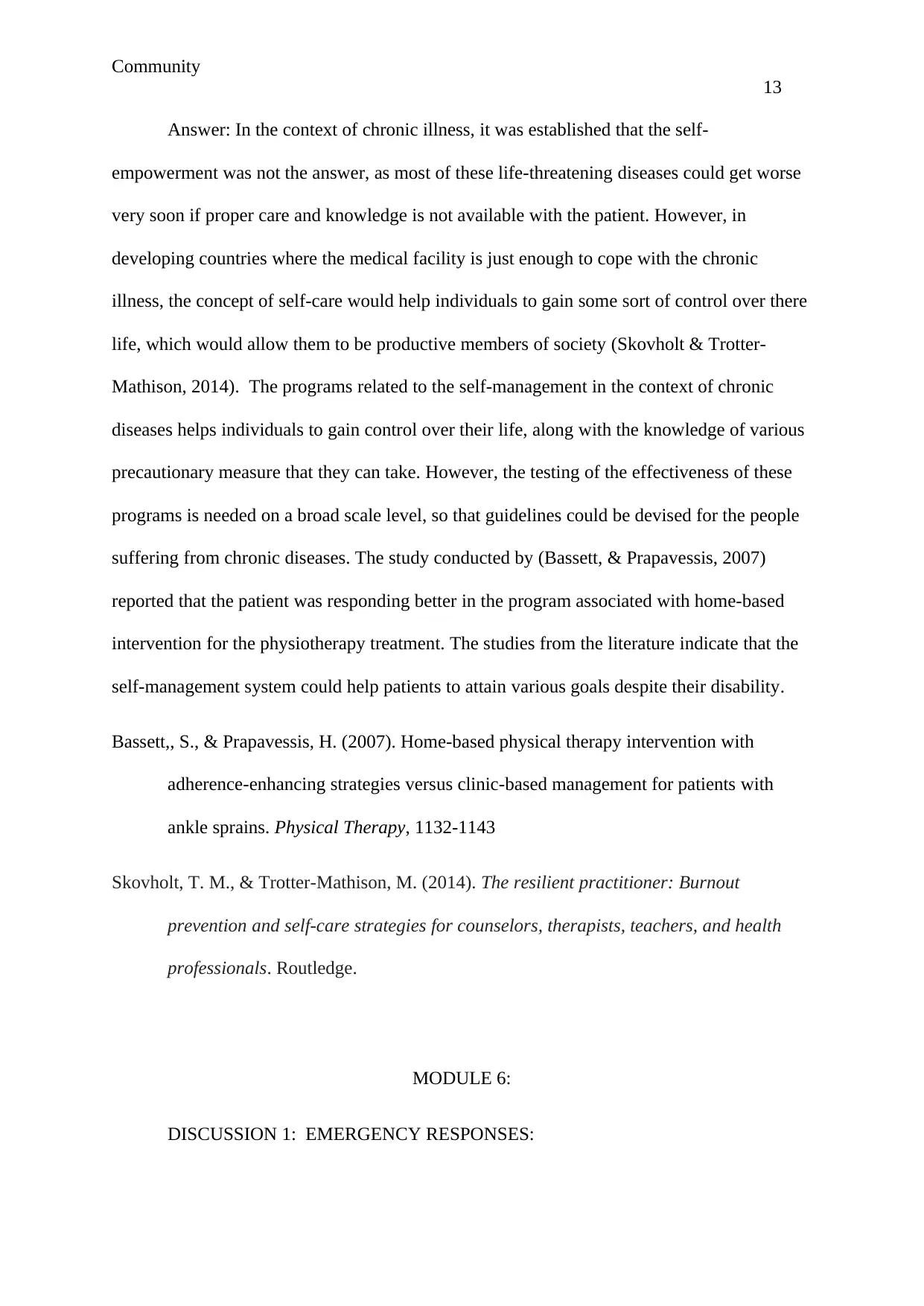
Community
13
Answer: In the context of chronic illness, it was established that the self-
empowerment was not the answer, as most of these life-threatening diseases could get worse
very soon if proper care and knowledge is not available with the patient. However, in
developing countries where the medical facility is just enough to cope with the chronic
illness, the concept of self-care would help individuals to gain some sort of control over there
life, which would allow them to be productive members of society (Skovholt & Trotter-
Mathison, 2014). The programs related to the self-management in the context of chronic
diseases helps individuals to gain control over their life, along with the knowledge of various
precautionary measure that they can take. However, the testing of the effectiveness of these
programs is needed on a broad scale level, so that guidelines could be devised for the people
suffering from chronic diseases. The study conducted by (Bassett, & Prapavessis, 2007)
reported that the patient was responding better in the program associated with home-based
intervention for the physiotherapy treatment. The studies from the literature indicate that the
self-management system could help patients to attain various goals despite their disability.
Bassett,, S., & Prapavessis, H. (2007). Home-based physical therapy intervention with
adherence-enhancing strategies versus clinic-based management for patients with
ankle sprains. Physical Therapy, 1132-1143
Skovholt, T. M., & Trotter-Mathison, M. (2014). The resilient practitioner: Burnout
prevention and self-care strategies for counselors, therapists, teachers, and health
professionals. Routledge.
MODULE 6:
DISCUSSION 1: EMERGENCY RESPONSES:
13
Answer: In the context of chronic illness, it was established that the self-
empowerment was not the answer, as most of these life-threatening diseases could get worse
very soon if proper care and knowledge is not available with the patient. However, in
developing countries where the medical facility is just enough to cope with the chronic
illness, the concept of self-care would help individuals to gain some sort of control over there
life, which would allow them to be productive members of society (Skovholt & Trotter-
Mathison, 2014). The programs related to the self-management in the context of chronic
diseases helps individuals to gain control over their life, along with the knowledge of various
precautionary measure that they can take. However, the testing of the effectiveness of these
programs is needed on a broad scale level, so that guidelines could be devised for the people
suffering from chronic diseases. The study conducted by (Bassett, & Prapavessis, 2007)
reported that the patient was responding better in the program associated with home-based
intervention for the physiotherapy treatment. The studies from the literature indicate that the
self-management system could help patients to attain various goals despite their disability.
Bassett,, S., & Prapavessis, H. (2007). Home-based physical therapy intervention with
adherence-enhancing strategies versus clinic-based management for patients with
ankle sprains. Physical Therapy, 1132-1143
Skovholt, T. M., & Trotter-Mathison, M. (2014). The resilient practitioner: Burnout
prevention and self-care strategies for counselors, therapists, teachers, and health
professionals. Routledge.
MODULE 6:
DISCUSSION 1: EMERGENCY RESPONSES:
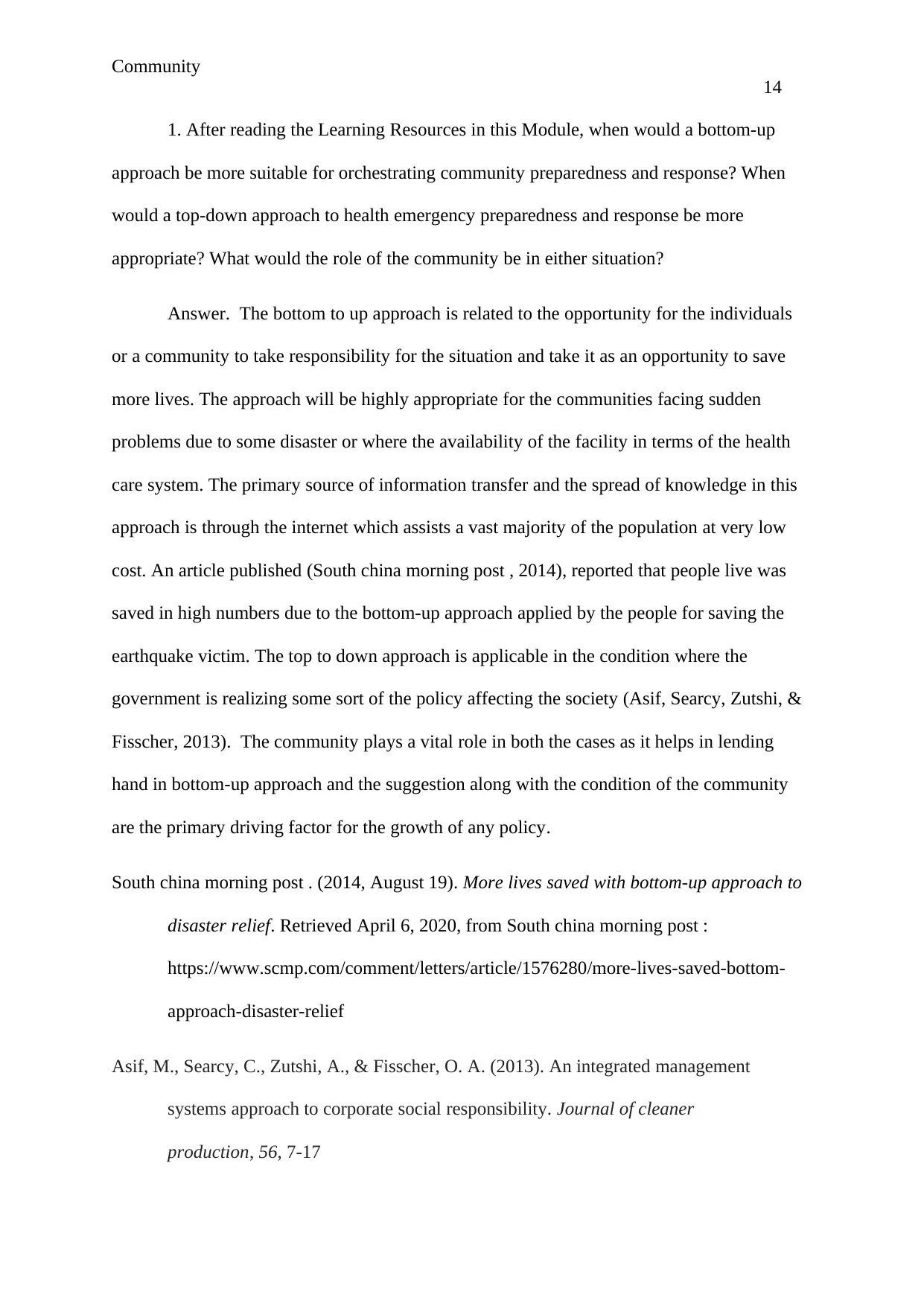
Community
14
1. After reading the Learning Resources in this Module, when would a bottom-up
approach be more suitable for orchestrating community preparedness and response? When
would a top-down approach to health emergency preparedness and response be more
appropriate? What would the role of the community be in either situation?
Answer. The bottom to up approach is related to the opportunity for the individuals
or a community to take responsibility for the situation and take it as an opportunity to save
more lives. The approach will be highly appropriate for the communities facing sudden
problems due to some disaster or where the availability of the facility in terms of the health
care system. The primary source of information transfer and the spread of knowledge in this
approach is through the internet which assists a vast majority of the population at very low
cost. An article published (South china morning post , 2014), reported that people live was
saved in high numbers due to the bottom-up approach applied by the people for saving the
earthquake victim. The top to down approach is applicable in the condition where the
government is realizing some sort of the policy affecting the society (Asif, Searcy, Zutshi, &
Fisscher, 2013). The community plays a vital role in both the cases as it helps in lending
hand in bottom-up approach and the suggestion along with the condition of the community
are the primary driving factor for the growth of any policy.
South china morning post . (2014, August 19). More lives saved with bottom-up approach to
disaster relief. Retrieved April 6, 2020, from South china morning post :
https://www.scmp.com/comment/letters/article/1576280/more-lives-saved-bottom-
approach-disaster-relief
Asif, M., Searcy, C., Zutshi, A., & Fisscher, O. A. (2013). An integrated management
systems approach to corporate social responsibility. Journal of cleaner
production, 56, 7-17
14
1. After reading the Learning Resources in this Module, when would a bottom-up
approach be more suitable for orchestrating community preparedness and response? When
would a top-down approach to health emergency preparedness and response be more
appropriate? What would the role of the community be in either situation?
Answer. The bottom to up approach is related to the opportunity for the individuals
or a community to take responsibility for the situation and take it as an opportunity to save
more lives. The approach will be highly appropriate for the communities facing sudden
problems due to some disaster or where the availability of the facility in terms of the health
care system. The primary source of information transfer and the spread of knowledge in this
approach is through the internet which assists a vast majority of the population at very low
cost. An article published (South china morning post , 2014), reported that people live was
saved in high numbers due to the bottom-up approach applied by the people for saving the
earthquake victim. The top to down approach is applicable in the condition where the
government is realizing some sort of the policy affecting the society (Asif, Searcy, Zutshi, &
Fisscher, 2013). The community plays a vital role in both the cases as it helps in lending
hand in bottom-up approach and the suggestion along with the condition of the community
are the primary driving factor for the growth of any policy.
South china morning post . (2014, August 19). More lives saved with bottom-up approach to
disaster relief. Retrieved April 6, 2020, from South china morning post :
https://www.scmp.com/comment/letters/article/1576280/more-lives-saved-bottom-
approach-disaster-relief
Asif, M., Searcy, C., Zutshi, A., & Fisscher, O. A. (2013). An integrated management
systems approach to corporate social responsibility. Journal of cleaner
production, 56, 7-17
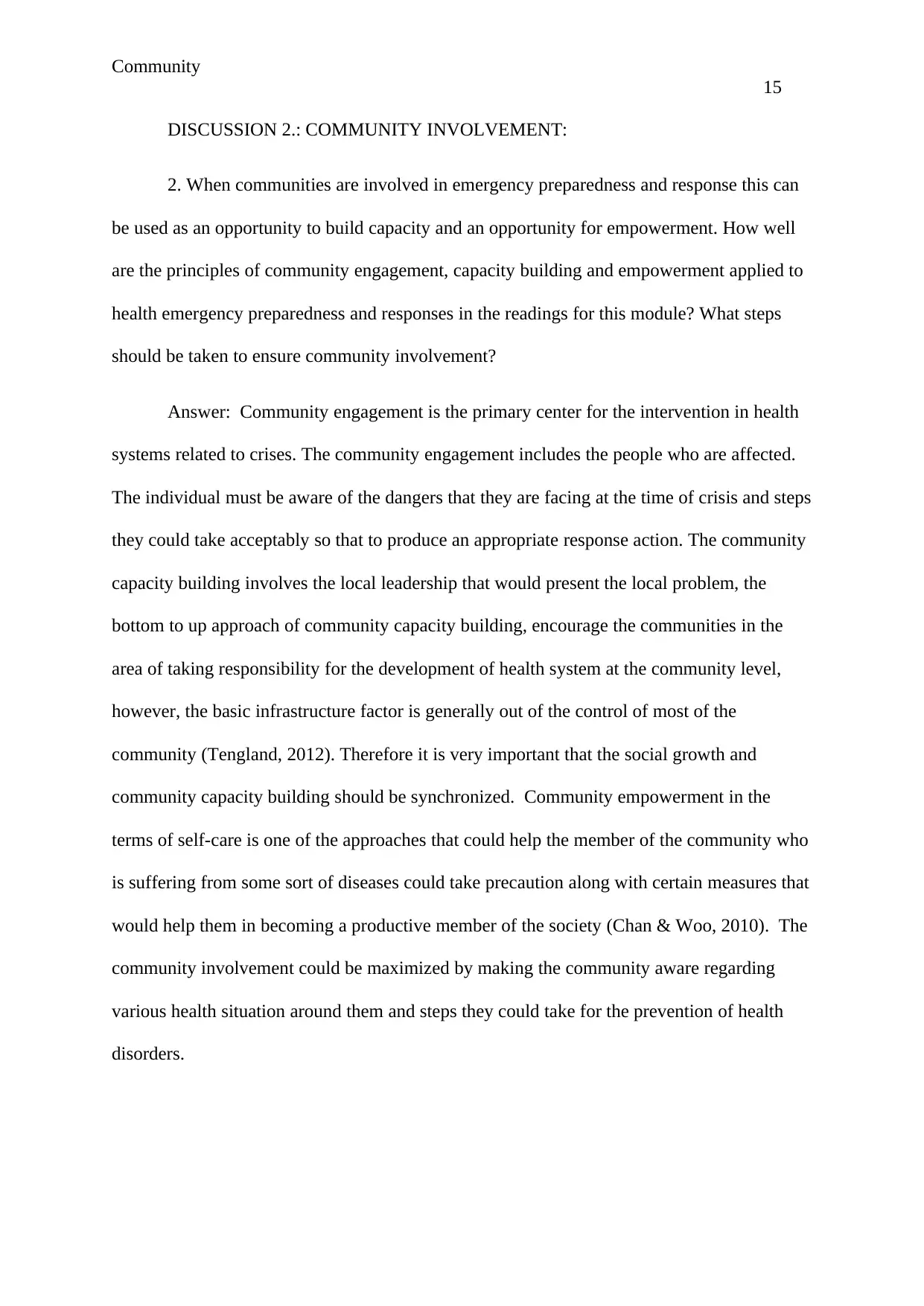
Community
15
DISCUSSION 2.: COMMUNITY INVOLVEMENT:
2. When communities are involved in emergency preparedness and response this can
be used as an opportunity to build capacity and an opportunity for empowerment. How well
are the principles of community engagement, capacity building and empowerment applied to
health emergency preparedness and responses in the readings for this module? What steps
should be taken to ensure community involvement?
Answer: Community engagement is the primary center for the intervention in health
systems related to crises. The community engagement includes the people who are affected.
The individual must be aware of the dangers that they are facing at the time of crisis and steps
they could take acceptably so that to produce an appropriate response action. The community
capacity building involves the local leadership that would present the local problem, the
bottom to up approach of community capacity building, encourage the communities in the
area of taking responsibility for the development of health system at the community level,
however, the basic infrastructure factor is generally out of the control of most of the
community (Tengland, 2012). Therefore it is very important that the social growth and
community capacity building should be synchronized. Community empowerment in the
terms of self-care is one of the approaches that could help the member of the community who
is suffering from some sort of diseases could take precaution along with certain measures that
would help them in becoming a productive member of the society (Chan & Woo, 2010). The
community involvement could be maximized by making the community aware regarding
various health situation around them and steps they could take for the prevention of health
disorders.
15
DISCUSSION 2.: COMMUNITY INVOLVEMENT:
2. When communities are involved in emergency preparedness and response this can
be used as an opportunity to build capacity and an opportunity for empowerment. How well
are the principles of community engagement, capacity building and empowerment applied to
health emergency preparedness and responses in the readings for this module? What steps
should be taken to ensure community involvement?
Answer: Community engagement is the primary center for the intervention in health
systems related to crises. The community engagement includes the people who are affected.
The individual must be aware of the dangers that they are facing at the time of crisis and steps
they could take acceptably so that to produce an appropriate response action. The community
capacity building involves the local leadership that would present the local problem, the
bottom to up approach of community capacity building, encourage the communities in the
area of taking responsibility for the development of health system at the community level,
however, the basic infrastructure factor is generally out of the control of most of the
community (Tengland, 2012). Therefore it is very important that the social growth and
community capacity building should be synchronized. Community empowerment in the
terms of self-care is one of the approaches that could help the member of the community who
is suffering from some sort of diseases could take precaution along with certain measures that
would help them in becoming a productive member of the society (Chan & Woo, 2010). The
community involvement could be maximized by making the community aware regarding
various health situation around them and steps they could take for the prevention of health
disorders.
Secure Best Marks with AI Grader
Need help grading? Try our AI Grader for instant feedback on your assignments.
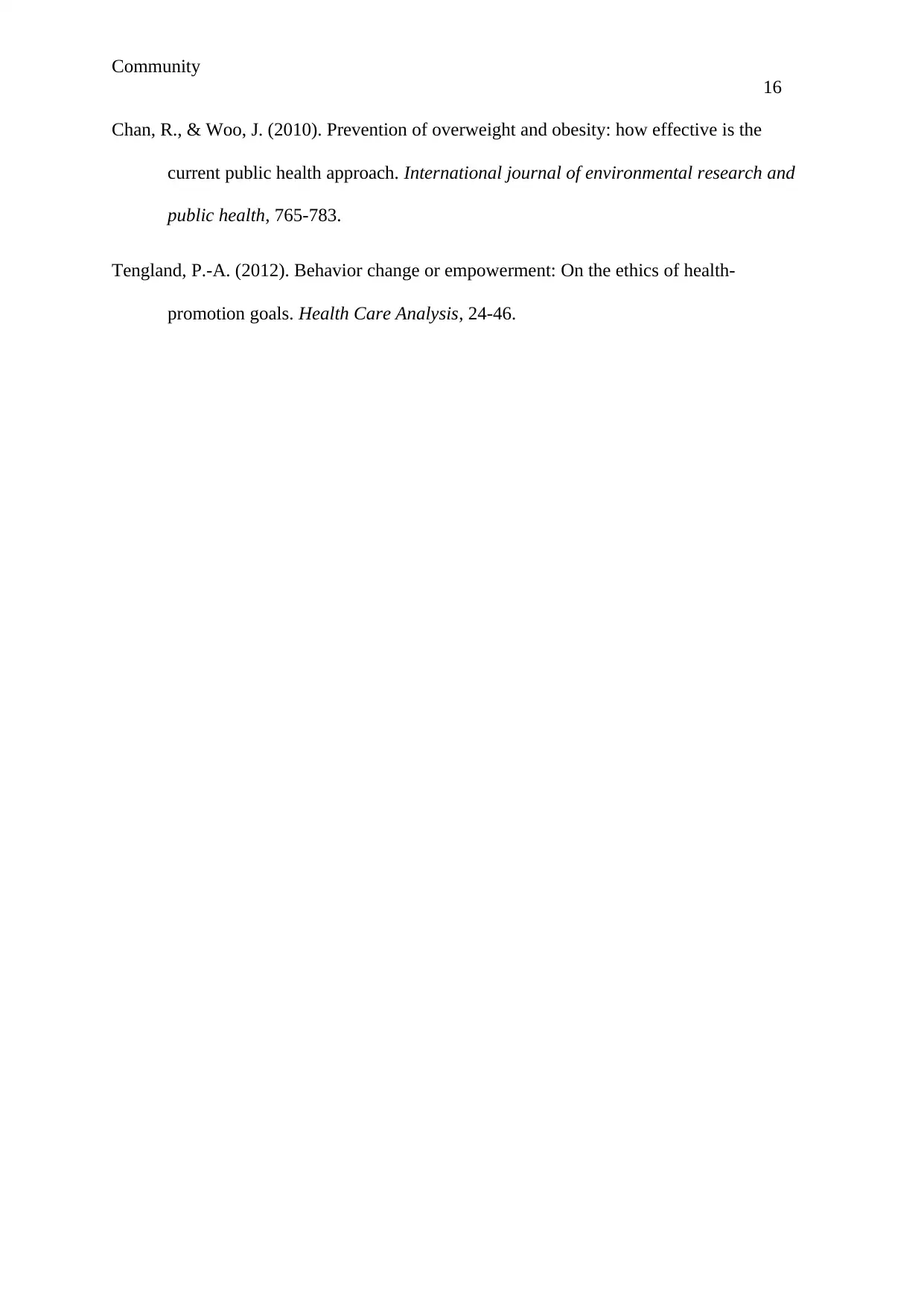
Community
16
Chan, R., & Woo, J. (2010). Prevention of overweight and obesity: how effective is the
current public health approach. International journal of environmental research and
public health, 765-783.
Tengland, P.-A. (2012). Behavior change or empowerment: On the ethics of health-
promotion goals. Health Care Analysis, 24-46.
16
Chan, R., & Woo, J. (2010). Prevention of overweight and obesity: how effective is the
current public health approach. International journal of environmental research and
public health, 765-783.
Tengland, P.-A. (2012). Behavior change or empowerment: On the ethics of health-
promotion goals. Health Care Analysis, 24-46.
1 out of 17
Your All-in-One AI-Powered Toolkit for Academic Success.
+13062052269
info@desklib.com
Available 24*7 on WhatsApp / Email
![[object Object]](/_next/static/media/star-bottom.7253800d.svg)
Unlock your academic potential
© 2024 | Zucol Services PVT LTD | All rights reserved.


